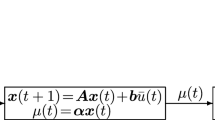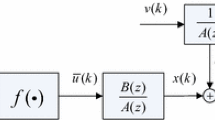Abstract
Identification of Hammerstein nonlinear models has received much attention due to its ability to describe a wide variety of nonlinear systems. In this paper the maximum likelihood estimator which was originally derived for linear systems is extended to work for Hammerstein nonlinear systems in colored-noise environment. The maximum likelihood estimate is known to be statistically efficient, but can lead to complex nonlinear multidimensional optimization problem; traditional methods solve this problem at the computational cost of evaluating second derivatives. To overcome these shortcomings, a particle swarm optimization (PSO) aided maximum likelihood identification algorithm (Maximum Likelihood-Particle Swarm Optimization, ML-PSO) is first proposed to integrate PSO’s simplicity in implementation and computation, and its ability to quickly converge to a reasonably good solution. Furthermore, a novel adaptive strategy using the evolution state estimation technique is proposed to improve PSO’s performance (maximum likelihood-adaptive particle swarm optimization, ML-APSO). A simulation example shows that ML-APSO method outperforms ML-PSO and traditional recursive least square method in various noise conditions, and thus proves the effectiveness of the proposed identification scheme.











Similar content being viewed by others
References
Bai, E.W.: Decoupling the linear and nonlinear parts in Hammerstein model identification. Automatica 40, 671–676 (2007)
Vanbeylen, L., Pintelon, R., Schoukens, J.: Blind maximum likelihood identification of Hammerstein systems. Automatica 44, 3139–3146 (2008)
Ding, F., Liu, X.P., Liu, G.: Identification methods for Hammerstein nonlinear systems. Digit. Signal Process. 21, 215–238 (2012)
Wang, D.Q., Ding, F.: Extended stochastic gradient identification algorithms for Hammerstein–Wiener ARMAX systems. Comput. Math. Appl. 56, 3157–3164 (2008)
Ding, F., Shi, Y., Chen, T.: Auxiliary model based least-square identification methods for Hammerstein output error systems. Syst. Control Lett. 56, 373–380 (2007)
Liu, X., Qian, J.: Modeling, control and optimization of ideal internal thermally coupled distillation columns. Chem. Eng. Technol. 23, 235–241 (2000)
Chen, Y., Liu, X.: Modeling mass transport of propylene polymerization on Ziegler–Natta catalyst. Polymer 46, 9434–9442 (2005)
Wang, D.Q., Ding, F.: Least squares based and gradient based iterative identification for Wiener nonlinear systems. Signal Process. 91, 1182–1189 (2011)
Li, J., Ding, F., Yang, G.: Maximum likelihood least squares identification method for input nonlinear finite impulse response moving average systems. Math. Comput. Model. 55, 442–450 (2012)
Zhu, Y., Liu, X.: Dynamics and control of high purity heat integrated distillation columns. Ind. Eng. Chem. Res. 44, 8806–8814 (2005)
Ding, F., Shi, Y., Chen, T.: Gradient-based identification methods for Hammerstein nonlinear ARMAX models. Nonlinear Dyn. 45, 31–43 (2005)
Narendra, K., Gallman, P.: An iterative method for the identification of nonlinear systems using a Hammerstein model. IEEE Trans. Autom. Control 11, 546–550 (1966)
Vörös, J.: Recursive identification of Hammerstein systems with discontinuous nonlinearities containing dead-zones. IEEE Trans. Autom. Control 48, 2203–2206 (2003)
Ding, F., Chen, T.: Identification of Hammerstein nonlinear ARMAX systems. Automatica 41, 1479–1489 (2005)
Yu, B., Fang, H., Lin, Y., Shi, Y.: Identification of Hammerstein output-error systems with two-segment nonlinearities: algorithm and applications. Control Intell. Syst. 38, 194–201 (2010)
Liu, Y., Xiao, Y., Zhao, X.: Multi-innovation stochastic gradient algorithm for multiple-input single-output systems using the auxiliary model. Appl. Math. Comput. 215, 1477–1483 (2009)
Liu, Y., Sheng, J., Ding, R.: Convergence of stochastic gradient estimation algorithm for multivariable ARX-like systems. Comput. Math. Appl. 59, 2615–2627 (2010)
Ding, F., Liu, G., Liu, X.: Parameter estimation with scarce measurements. Automatica 47, 1646–1655 (2011)
Ding, F.: Hierarchical multi-innovation stochastic gradient algorithm for Hammerstein nonlinear system modeling. Appl. Math. Model. 37, 1694–1704 (2013)
LL-Duwaish, H., Karim, M.: A new method for the identification of Hammerstein Model. Automatica 33, 1871–1875 (1997)
Lang, Z.: A nonparametric polynomial identification algorithm for the Hammerstein system. IEEE Trans. Autom. Control 42, 1435–1441 (1997)
Wang, J., Sano, A., Chen, T., Huang, B.: Identification of Hammerstein systems without explicit parameterization of non-linearity. Int. J. Control 82, 937–952 (2009)
Chen, C.H., Fassois, S.D.: Maximum likelihood identification of stochastic Wiener–Hammerstein-type non-linear systems. Mech. Syst. Signal Process. 6, 135–153 (1992)
Ljung, L.: System Identification: Theory for the User. Prentice Hall, Englewood Cliffs (1987)
Hagenblad, A., Ljung, L.: Maximum likelihood identification of Wiener models. Automatica 44, 2697–2705 (2008)
Chen, S., Hong, X., Harris, C.J.: Particle swarm optimization aided orthogonal forward regression of unified data modeling. IEEE Trans. Evol. Comput. 14, 477–499 (2010)
Konstantinos, T., Grigorios, B., Spiridon, L.: Combining evolutionary and stochastic gradient techniques for system identification. J. Comput. Appl. Math. 2(27), 147–160 (2009)
Bai, E.W.: An optimal two-stage identification algorithm for Hammerstein–Wiener nonlinear systems. Automatica 34, 333–338 (1998)
Chang, F., Luus, R.: A noniterative method for identification using Hammerstein model. IEEE Trans. Autom. Control 16, 464–468 (1971)
Bai, E.W.: A blind approach to the Hammerstein–Wiener model identification. Automatica 38, 967–979 (2002)
Astrom, K.J.: Maximum likelihood and prediction error methods. Automatica 16, 551–574 (1980)
Wang, W., Ding, F., Dai, J.: Maximum likelihood least squares identification for systems with autoregressive moving average noise. Appl. Math. Model. 36, 1842–1853 (2012)
Eberhart, R., Kennedy, J.: A new optimizer using particle swarm theory. In: Proceedings of the Sixth International Symposium on Micro Machine and Human Science, Nagoya, Japan, pp. 39–43 (1995)
Shi, Y., Eberhart, R.: Fuzzy adaptive particle swarm optimization. In: Proceedings of the 2001 Congress on Evolutionary Computation, pp. 101–106 (2001)
Clerc, M., Kennedy, J.: The particle swarm—explosion, stability, and convergence in a multidimensional complex space. IEEE Trans. Evol. Comput. 6, 58–73 (2002)
Kadirkamanathan, V., Selvarajah, K., Fleming, P.J.: Stability analysis of the particle dynamics in particle swarm optimizer. IEEE Trans. Evol. Comput. 10, 245–255 (2006)
Trelea, I.C.: The particle swarm optimization algorithm: convergence analysis and parameter selection. Inf. Process. Lett. 85, 317–325 (2003)
Kennedy, J., Mendes, R.: Neighborhood topologies in fully-informed and best-of-neighborhood particle swarms. In: Proceedings of the 2003 IEEE SMC Workshop on Soft Computing in Industrial Applications (SMCia03), Binghamton, New York (2003)
Suganthan, P.N.: Particle swarm optimizer with neighborhood operator. In: Proceedings of the 1999 Congress on Evolutionary Computation, vol. 3, pp. 1958–1962 (1999)
Ratnaweera, A., Halgamuge, S.K., Watson, H.C.: Self-organizing hierarchical particle swarm optimizer with time-varying acceleration coefficients. IEEE Trans. Evol. Comput. 8, 240–255 (2004)
Zhan, Z.H., Zhang, J., Li, Y., Chung, H.S.: Adaptive particle swarm optimization. IEEE Trans. Syst. Man Cybern., Part B 39, 1362–1381 (2009)
Liu, X., Lu, J.: Least squares based iterative identification for a class of multirate systems. Automatica 46, 549–554 (2010)
Acknowledgements
This work was supported by Joint Funds of NSFC-CNPC of China (Grant U1162130), National High Technology Research and Development Program (863, Grant 2006AA05Z226) and Zhejiang Provincial Natural Science Foundation for Distinguished Young Scientists (Grant R4100133).
Author information
Authors and Affiliations
Corresponding author
Rights and permissions
About this article
Cite this article
Sun, J., Liu, X. A novel APSO-aided maximum likelihood identification method for Hammerstein systems. Nonlinear Dyn 73, 449–462 (2013). https://doi.org/10.1007/s11071-013-0800-4
Received:
Accepted:
Published:
Issue Date:
DOI: https://doi.org/10.1007/s11071-013-0800-4




